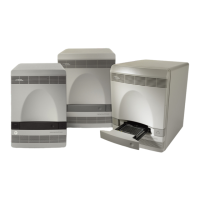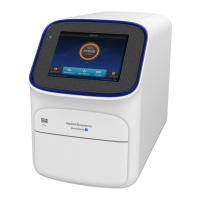DRAFT
June 23, 2003 9:39 am, MFC_QSG_text.fm
Introduction
Applied Biosystems Micro Fluidic Card Getting Started Guide 5
• Provides access to high-throughput, 384-well format without
liquid-handling robotics
• Micro Fluidic Cards, when used with the 7900HT system, detect
2-fold discrimination at the 99.7% confidence level
More Information About Micro Fluidic Cards
Chapter 4 of the user guide for the 7900HT system contains more
information about the Micro Fluidic Card, including
• How it works – The Micro Fluidic Card functions as an array of
reaction vessels for the PCR/sequence detection step.
• Card components – Each card is a specially developed 384-well
consumable divided into eight sets of assays.
• Internal Structure – Micro Fluidic Cards have fill reservoirs, or
ports, into which you load your samples.
• Detectors – Micro Fluidic Cards permit the amplification of the
endogenous control and targets in cDNA samples using
fluorogenic 5´ nuclease assays.
Note: Real-time PCR in Micro Fluidic Cards are run as singleplex
reactions.
About Micro
Fluidic Card
Chemistry
Micro Fluidic Card experiments use a two-step RT-PCR process. In
the reverse-transcription (RT) step, cDNA is reverse transcribed from
total RNA samples using random primers from the High Capacity
cDNA Archive Kit. Additional details about the RT-PCR process are
contained in the High Capacity cDNA Archive Kit Protocol
(PN 4322169).
In the PCR step, PCR products are synthesized from cDNA samples
using the TaqMan Universal PCR Master Mix. The PCR step
employs the 5´ nuclease assay, which is described in Appendix C of
the user guide for the 7900HT system.
Preventing
Contamination
PCR assays require special laboratory practices to avoid false
positive amplifications (Kwok and Higuchi, 1989). The high
throughput and repetition of these assays can lead to amplification of
a single DNA molecule (Saiki et al., 1985; Mullis and Faloona,
1987).
For more information about preventing contamination, refer to
Chapter 4 of the user guide for the 7900HT system.

